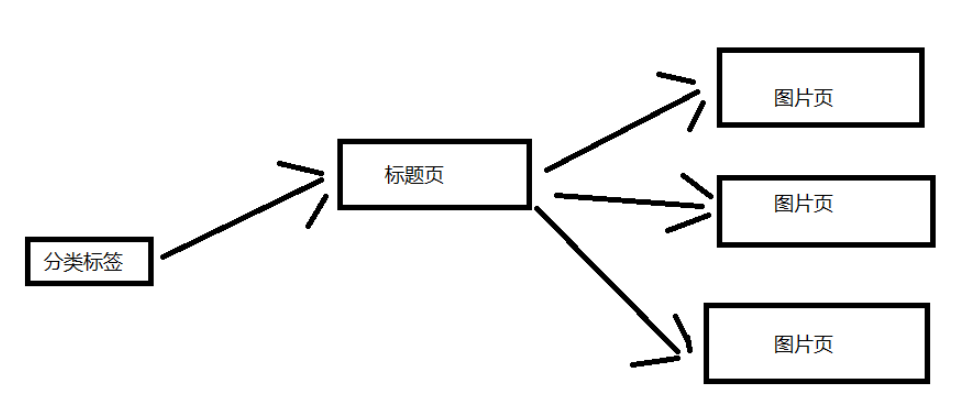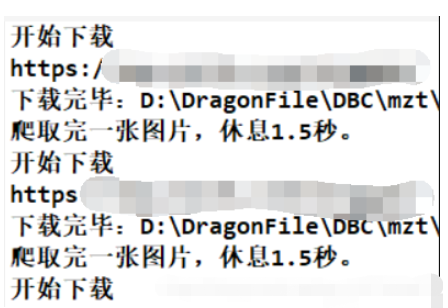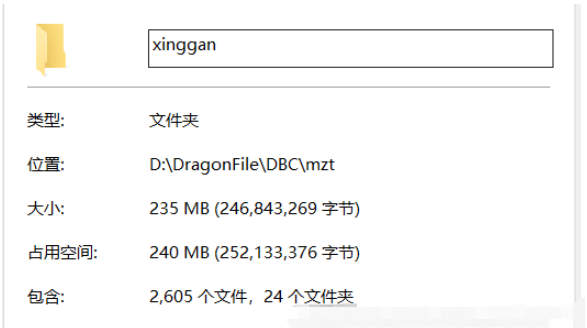您好,登錄后才能下訂單哦!
您好,登錄后才能下訂單哦!
本篇內容主要講解“怎么使用Java爬蟲批量爬取圖片”,感興趣的朋友不妨來看看。本文介紹的方法操作簡單快捷,實用性強。下面就讓小編來帶大家學習“怎么使用Java爬蟲批量爬取圖片”吧!
對于這種圖片的獲取,其實本質上就是就是文件的下載(HttpClient)。但是因為不只是獲取一張圖片,所以還會有一個頁面解析的處理過程(Jsoup)。
Jsoup:解析html頁面,獲取圖片的鏈接。
HttpClient:請求圖片的鏈接,保存圖片到本地。
首先進入首頁分析,主要有以下幾個分類(這里不是全部分類,但是這幾個也足夠了,這只是學習技術而已。),我們的目標就是獲取每個分類下的圖片。
這里來分析一下網站的結構,我這里就簡單一點吧。 下面這張圖片是大致的結構,這里選取一個分類標簽進行說明。 一個分類標簽頁含有多個標題頁,然后每個標題頁含有多個圖片頁。(對應標題頁的幾十張圖片)

導入項目依賴jar包坐標或者直接下載對應的jar包,導入項目也可。
<dependency> <groupId>org.apache.httpcomponents</groupId> <artifactId>httpclient</artifactId> <version>4.5.6</version> </dependency> <dependency> <groupId>org.jsoup</groupId> <artifactId>jsoup</artifactId> <version>1.11.3</version> </dependency>
實體類:把屬性封裝成一個對象,這樣調用方便一點。
package com.picture;
public class Picture {
private String title;
private String url;
public Picture(String title, String url) {
this.title = title;
this.url = url;
}
public String getTitle() {
return this.title;
}
public String getUrl() {
return this.url;
}
}工具類:不斷變換 UA(我也不知道有沒有用,不過我是使用自己的ip,估計用處不大了)
package com.picture;
public class HeaderUtil {
public static String[] headers = {
"Mozilla/5.0 (Windows NT 6.3; WOW64) AppleWebKit/537.36 (KHTML, like Gecko) Chrome/39.0.2171.95 Safari/537.36",
"Mozilla/5.0 (Macintosh; Intel Mac OS X 10_9_2) AppleWebKit/537.36 (KHTML, like Gecko) Chrome/35.0.1916.153 Safari/537.36",
"Mozilla/5.0 (Windows NT 6.1; WOW64; rv:30.0) Gecko/20100101 Firefox/30.0",
"Mozilla/5.0 (Macintosh; Intel Mac OS X 10_9_2) AppleWebKit/537.75.14 (KHTML, like Gecko) Version/7.0.3 Safari/537.75.14",
"Mozilla/5.0 (compatible; MSIE 10.0; Windows NT 6.2; Win64; x64; Trident/6.0)",
"Mozilla/5.0 (Windows; U; Windows NT 5.1; it; rv:1.8.1.11) Gecko/20071127 Firefox/2.0.0.11",
"Opera/9.25 (Windows NT 5.1; U; en)",
"Mozilla/4.0 (compatible; MSIE 6.0; Windows NT 5.1; SV1; .NET CLR 1.1.4322; .NET CLR 2.0.50727)",
"Mozilla/5.0 (compatible; Konqueror/3.5; Linux) KHTML/3.5.5 (like Gecko) (Kubuntu)",
"Mozilla/5.0 (X11; U; Linux i686; en-US; rv:1.8.0.12) Gecko/20070731 Ubuntu/dapper-security Firefox/1.5.0.12",
"Lynx/2.8.5rel.1 libwww-FM/2.14 SSL-MM/1.4.1 GNUTLS/1.2.9",
"Mozilla/5.0 (X11; Linux i686) AppleWebKit/535.7 (KHTML, like Gecko) Ubuntu/11.04 Chromium/16.0.912.77 Chrome/16.0.912.77 Safari/535.7",
"Mozilla/5.0 (X11; Ubuntu; Linux i686; rv:10.0) Gecko/20100101 Firefox/10.0 "
};
}多線程實在是太快了,再加上我只有一個ip,沒有代理ip可以用(我也不太了解),使用多線程被封ip是很快的。
package com.picture;
import java.io.BufferedOutputStream;
import java.io.File;
import java.io.FileOutputStream;
import java.io.IOException;
import java.io.OutputStream;
import java.util.Random;
import org.apache.http.HttpEntity;
import org.apache.http.client.ClientProtocolException;
import org.apache.http.client.methods.CloseableHttpResponse;
import org.apache.http.client.methods.HttpGet;
import org.apache.http.impl.client.CloseableHttpClient;
import org.apache.http.util.EntityUtils;
import com.m3u8.HttpClientUtil;
public class SinglePictureDownloader {
private String referer;
private CloseableHttpClient httpClient;
private Picture picture;
private String filePath;
public SinglePictureDownloader(Picture picture, String referer, String filePath) {
this.httpClient = HttpClientUtil.getHttpClient();
this.picture = picture;
this.referer = referer;
this.filePath = filePath;
}
public void download() {
HttpGet get = new HttpGet(picture.getUrl());
Random rand = new Random();
//設置請求頭
get.setHeader("User-Agent", HeaderUtil.headers[rand.nextInt(HeaderUtil.headers.length)]);
get.setHeader("referer", referer);
System.out.println(referer);
HttpEntity entity = null;
try (CloseableHttpResponse response = httpClient.execute(get)) {
int statusCode = response.getStatusLine().getStatusCode();
if (statusCode == 200) {
entity = response.getEntity();
if (entity != null) {
File picFile = new File(filePath, picture.getTitle());
try (OutputStream out = new BufferedOutputStream(new FileOutputStream(picFile))) {
entity.writeTo(out);
System.out.println("下載完畢:" + picFile.getAbsolutePath());
}
}
}
} catch (ClientProtocolException e) {
e.printStackTrace();
} catch (IOException e) {
e.printStackTrace();
} finally {
try {
//關閉實體,關于 httpClient 的關閉資源,有點不太了解。
EntityUtils.consume(entity);
} catch (IOException e) {
e.printStackTrace();
}
}
}
}這是獲取 HttpClient 連接的工具類,避免頻繁創建連接的性能消耗。(但是因為我這里是使用單線程來爬取,所以用處就不大了。我就是可以只使用一個HttpClient連接來爬取,這是因為我剛開始是使用多線程來爬取的,但是基本獲取幾張圖片就被禁掉了,所以改成單線程爬蟲。所以這個連接池也就留下來了。)
package com.m3u8;
import org.apache.http.client.config.RequestConfig;
import org.apache.http.impl.client.CloseableHttpClient;
import org.apache.http.impl.client.HttpClients;
import org.apache.http.impl.conn.PoolingHttpClientConnectionManager;
public class HttpClientUtil {
private static final int TIME_OUT = 10 * 1000;
private static PoolingHttpClientConnectionManager pcm; //HttpClient 連接池管理類
private static RequestConfig requestConfig;
static {
requestConfig = RequestConfig.custom()
.setConnectionRequestTimeout(TIME_OUT)
.setConnectTimeout(TIME_OUT)
.setSocketTimeout(TIME_OUT).build();
pcm = new PoolingHttpClientConnectionManager();
pcm.setMaxTotal(50);
pcm.setDefaultMaxPerRoute(10); //這里可能用不到這個東西。
}
public static CloseableHttpClient getHttpClient() {
return HttpClients.custom()
.setConnectionManager(pcm)
.setDefaultRequestConfig(requestConfig)
.build();
}
}package com.picture;
import java.io.File;
import java.io.IOException;
import java.util.List;
import java.util.Map;
import java.util.stream.Collectors;
import org.apache.http.HttpEntity;
import org.apache.http.client.ClientProtocolException;
import org.apache.http.client.methods.CloseableHttpResponse;
import org.apache.http.client.methods.HttpGet;
import org.apache.http.impl.client.CloseableHttpClient;
import org.apache.http.util.EntityUtils;
import org.jsoup.Jsoup;
import org.jsoup.nodes.Document;
import org.jsoup.select.Elements;
import com.m3u8.HttpClientUtil;
/**
* 首先從頂部分類標題開始,依次爬取每一個標題(小分頁),每一個標題(大分頁。)
* */
public class PictureSpider {
private CloseableHttpClient httpClient;
private String referer;
private String rootPath;
private String filePath;
public PictureSpider() {
httpClient = HttpClientUtil.getHttpClient();
}
/**
* 開始爬蟲爬取!
*
* 從爬蟲隊列的第一條開始,依次爬取每一條url。
*
* 分頁爬取:爬10頁
* 每個url屬于一個分類,每個分類一個文件夾
* */
public void start(List<String> urlList) {
urlList.stream().forEach(url->{
this.referer = url;
String dirName = url.substring(22, url.length()-1); //根據標題名字去創建目錄
//創建分類目錄
File path = new File("D:/DragonFile/DBC/mzt/", dirName); //硬編碼路徑,需要用戶自己指定一個
if (!path.exists()) {
path.mkdir();
rootPath = path.toString();
}
for (int i = 1; i <= 10; i++) { //分頁獲取圖片數據,簡單獲取幾頁就行了
this.page(url + "page/"+ 1);
}
});
}
/**
* 標題分頁獲取鏈接
* */
public void page(String url) {
System.out.println("url:" + url);
String html = this.getHtml(url); //獲取頁面數據
Map<String, String> picMap = this.extractTitleUrl(html); //抽取圖片的url
if (picMap == null) {
return ;
}
//獲取標題對應的圖片頁面數據
this.getPictureHtml(picMap);
}
private String getHtml(String url) {
String html = null;
HttpGet get = new HttpGet(url);
get.setHeader("User-Agent", "Mozilla/5.0 (Windows NT 10.0; Win64; x64) AppleWebKit/537.36 (KHTML, like Gecko) Chrome/60.0.3100.0 Safari/537.36");
get.setHeader("referer", url);
try (CloseableHttpResponse response = httpClient.execute(get)) {
int statusCode = response.getStatusLine().getStatusCode();
if (statusCode == 200) {
HttpEntity entity = response.getEntity();
if (entity != null) {
html = EntityUtils.toString(entity, "UTf-8"); //關閉實體?
}
}
else {
System.out.println(statusCode);
}
} catch (ClientProtocolException e) {
e.printStackTrace();
} catch (IOException e) {
e.printStackTrace();
}
return html;
}
private Map<String, String> extractTitleUrl(String html) {
if (html == null) {
return null;
}
Document doc = Jsoup.parse(html, "UTF-8");
Elements pictures = doc.select("ul#pins > li");
//不知為何,無法直接獲取 a[0],我不太懂這方面的知識。
//那我就多處理一步,這里先放下。
Elements pictureA = pictures.stream()
.map(pic->pic.getElementsByTag("a").first())
.collect(Collectors.toCollection(Elements::new));
return pictureA.stream().collect(Collectors.toMap(
pic->pic.getElementsByTag("img").first().attr("alt"),
pic->pic.attr("href")));
}
/**
* 進入每一個標題的鏈接,再次分頁獲取圖片的鏈接
* */
private void getPictureHtml(Map<String, String> picMap) {
//進入標題頁,在標題頁中再次分頁下載。
picMap.forEach((title, url)->{
//分頁下載一個系列的圖片,每個系列一個文件夾。
File dir = new File(rootPath, title.trim());
if (!dir.exists()) {
dir.mkdir();
filePath = dir.toString(); //這個 filePath 是每一個系列圖片的文件夾
}
for (int i = 1; i <= 60; i++) {
String html = this.getHtml(url + "/" + i);
if (html == null) {
//每個系列的圖片一般沒有那么多,
//如果返回的頁面數據為 null,那就退出這個系列的下載。
return ;
}
Picture picture = this.extractPictureUrl(html);
System.out.println("開始下載");
//多線程實在是太快了(快并不是好事,我改成單線程爬取吧)
SinglePictureDownloader downloader = new SinglePictureDownloader(picture, referer, filePath);
downloader.download();
try {
Thread.sleep(1500); //不要爬的太快了,這里只是學習爬蟲的知識。不要擾亂別人的正常服務。
System.out.println("爬取完一張圖片,休息1.5秒。");
} catch (InterruptedException e) {
e.printStackTrace();
}
}
});
}
/**
* 獲取每一頁圖片的標題和鏈接
* */
private Picture extractPictureUrl(String html) {
Document doc = Jsoup.parse(html, "UTF-8");
//獲取標題作為文件名
String title = doc.getElementsByTag("h3")
.first()
.text();
//獲取圖片的鏈接(img 標簽的 src 屬性)
String url = doc.getElementsByAttributeValue("class", "main-image")
.first()
.getElementsByTag("img")
.attr("src");
//獲取圖片的文件擴展名
title = title + url.substring(url.lastIndexOf("."));
return new Picture(title, url);
}
}這里有一個爬蟲隊列,但是我最終連第一個都沒有爬取完,這是因為我計算失誤了,少算了兩個數量級。但是,程序的功能是正確的。
package com.picture;
import java.util.ArrayList;
import java.util.Arrays;
import java.util.List;
/**
* 爬蟲啟動類
* */
public class BootStrap {
public static void main(String[] args) {
//反爬措施:UA、refer 簡單繞過就行了。
//refer https://www.mzitu.com
//使用數組做一個爬蟲隊列
String[] urls = new String[] {
"https://www.mzitu.com/xinggan/",
"https://www.mzitu.com/zipai/"
};
// 添加初始隊列,啟動爬蟲
List<String> urlList = new ArrayList<>(Arrays.asList(urls));
PictureSpider spider = new PictureSpider();
spider.start(urlList);
}
}

這里有一個計算失誤,代碼如下:
for (int i = 1; i <= 10; i++) { //分頁獲取圖片數據,簡單獲取幾頁就行了
this.page(url + "page/"+ 1);
}這個 i 的取值過大了,因為我計算的時候失誤了。如果按照這個情況下載的話,總共會下載:4 * 10 * (30-5) * 60 = 64800 張。(每一頁是含有30個標題頁,大概5個是廣告。) 我一開始以為只有幾百張圖片! 這是一個估計值,但是真實的下載量和這個不會差太多的(沒有數量級的差距)。所以我下載了一會發現只下載了第一個隊列里面的圖片。當然了,作為一個爬蟲學習的程序,它還是很合格的。
這個程序只是用來學習的,我設置每張圖片的下載間隔時間是1.5秒,而且是單線程的程序,所以速度上會顯得很慢。但是那樣也沒有關系,只要程序的功能正確就行了,應該沒有人會真的等到圖片下載完吧。
那估計要好久了:64800*1.5s = 97200s = 27h,這也只是一個粗略的估計值,沒有考慮程序的其他運行時間,不過其他時間可以基本忽略了。
到此,相信大家對“怎么使用Java爬蟲批量爬取圖片”有了更深的了解,不妨來實際操作一番吧!這里是億速云網站,更多相關內容可以進入相關頻道進行查詢,關注我們,繼續學習!
免責聲明:本站發布的內容(圖片、視頻和文字)以原創、轉載和分享為主,文章觀點不代表本網站立場,如果涉及侵權請聯系站長郵箱:is@yisu.com進行舉報,并提供相關證據,一經查實,將立刻刪除涉嫌侵權內容。